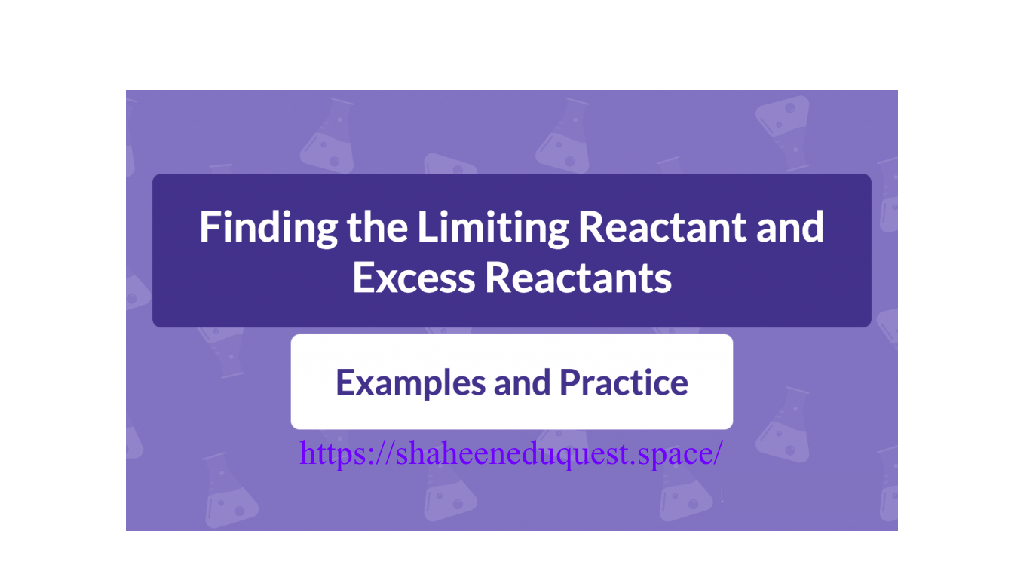Among the key concepts in stoichiometry, the limiting reactant (also known as the limiting reagent) plays a pivotal role in determining how much product is formed during a chemical reaction. Without identifying the limiting reactant, one cannot accurately calculate yields or understand reaction efficiency.
Table of Contents
What Is a Limiting Reactant?
In a chemical reaction, the limiting reactant is the substance that is entirely consumed first. Once it is used up, the reaction cannot continue, and no more product can form—even if other reactants are still present in excess. The amount of the limiting reactant determines the maximum yield of the reaction.
Definition:
A limiting reactant is the reactant in a chemical reaction that limits the amount of product that can be formed. It is completely consumed when the reaction goes to completion.
Why Is the Limiting Reactant Important?
Knowing the limiting reactant is crucial for several reasons:
- It allows chemists to predict the amount of product formed.
- It helps in calculating the percent yield of a reaction.
- It prevents the waste of expensive or hazardous chemicals by identifying excess materials.
- It is essential in industrial manufacturing where efficiency and cost-effectiveness are priorities.
Basic Stoichiometry Review
Before identifying the limiting reactant, you must understand stoichiometry, which involves the quantitative relationship between reactants and products in a chemical equation. Stoichiometry uses mole ratios derived from balanced chemical equations to relate amounts of substances involved in reactions.
Steps to Identify the Limiting Reactant
To find the Limiting Reactant in a reaction, follow these steps:
✅ Step 1: Write the balanced chemical equation.
This ensures the proper mole ratios between reactants and products are used.
✅ Step 2: Convert all given quantities (usually in grams) to moles.
Use the formula: moles=mass (g)molar mass (g/mol)\text{moles} = \frac{\text{mass (g)}}{\text{molar mass (g/mol)}}moles=molar mass (g/mol)mass (g)
✅ Step 3: Use the mole ratio from the balanced equation to determine the theoretical amount of product each reactant can produce.
✅ Step 4: Identify which reactant produces the least amount of product.
The reactant that forms the lesser amount of product is the Limiting Reactant.
Limiting Reactant Example (Step-by-Step)
Let’s walk through an example to solidify the concept.
Example:
Consider the reaction: 2H2+O2→2H2O2H_2 + O_2 \rightarrow 2H_2O2H2+O2→2H2O
Suppose we have 10 grams of hydrogen gas (H₂) and 80 grams of oxygen gas (O₂). Which is the limiting reactant?
✅ Step 1: Molar Masses
- Molar mass of H₂ = 2.02 g/mol
- Molar mass of O₂ = 32.00 g/mol
✅ Step 2: Convert to moles
- Moles of H₂ = 10 / 2.02 ≈ 4.95 mol
- Moles of O₂ = 80 / 32 = 2.50 mol
✅ Step 3: Mole Ratio from equation
- From the balanced equation: 2 mol H₂ reacts with 1 mol O₂
Let’s find how much H₂ is needed to react with 2.5 mol of O₂: 2.5 mol O₂×2 mol H₂1 mol O₂=5.0 mol H₂2.5 \text{ mol O₂} \times \frac{2 \text{ mol H₂}}{1 \text{ mol O₂}} = 5.0 \text{ mol H₂}2.5 mol O₂×1 mol O₂2 mol H₂=5.0 mol H₂
But we only have 4.95 mol of H₂, which is less than required.
✅ Conclusion:
Since 4.95 mol H₂ is not enough to react with all the O₂, H₂ is the limiting reactant.

Excess Reactant
The excess reactant is the one that remains unreacted after the reaction is complete. In our example above, O₂ is the excess reactant.
You can calculate how much of the excess reactant is left using stoichiometry.
Real-World Applications of Limiting Reactants
🧪 1. Pharmaceutical Industry
Drug manufacturers must ensure precise reactant ratios to avoid excess chemicals that can lead to costly purification processes or toxic residues.
🚗 2. Automotive Industry
Air-fuel ratios in car engines are calculated based on limiting reactants to ensure complete combustion and reduce emissions.
🍰 3. Baking and Cooking
In recipes, if you run out of flour before other ingredients, flour becomes the limiting “reactant,” determining how many cookies you can bake.
🔬 4. Environmental Chemistry
Limiting reactant concepts are used in pollution control to determine how much reactant is needed to neutralize contaminants.
Common Mistakes in Identifying Limiting Reactants
- Not balancing the chemical equation: Skipping this step leads to incorrect mole ratios.
- Not converting grams to moles: Always work with moles when comparing reactants.
- Assuming the smaller mass is the limiting reactant: The limiting reactant is based on mole ratios, not just mass.
Key Rules of limiting reactant
| Rule | Description |
|---|---|
| 1 | Always start with a balanced chemical equation. |
| 2 | Convert all reactant amounts to moles. |
| 3 | Use mole-to-mole ratios to compare reactants. |
| 4 | The reactant that produces the least amount of product is the limiting one. |
| 5 | Once identified, use the limiting reactant to calculate product yield. |
limiting reactant vs Excess Reactant: Comparison Table
| Feature | Limiting Reactant | Excess Reactant |
|---|---|---|
| Amount | Used up first | Remains unreacted |
| Determines | Amount of product | Amount left over |
| Identified by | Stoichiometry (least product) | Remainder after reaction |
| Example | H₂ in reaction with O₂ | O₂ in reaction with H₂ |
Practice Problem
Question: Given 5 grams of aluminum (Al) and 10 grams of chlorine gas (Cl₂), determine the limiting reactant in the reaction: 2Al+3Cl2→2AlCl32Al + 3Cl_2 \rightarrow 2AlCl_32Al+3Cl2→2AlCl3
Try it yourself!
Conclusion
Understanding the concept of limiting reactants is essential in chemistry, whether you’re solving academic problems or optimizing industrial processes. It helps in maximizing efficiency, minimizing waste, and making informed decisions based on quantitative analysis.
By following a structured approach—balancing equations, converting to moles, applying mole ratios—you can accurately identify the limiting reactant in any chemical reaction
